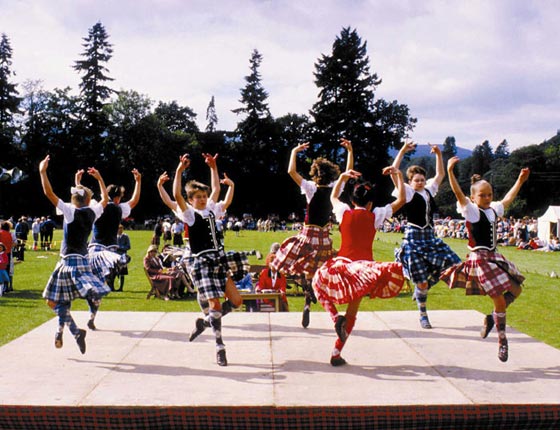Highland Dancing Dance is common to all cultures. Most of the true Highland dances are connected with ancient Scottish folk customs. The present form evolved through the centuries as refinement in the general form of dance occurred, but the original basic steps and the themes were passed on through the years.
No event at Highland games encompasses such verve, enthusiasm and color as Highland Dancing and what better sight and sound can there be that encapsulates the very essence of Scotland than the bagpipes accompanying a kilted dancer, swaying and pirouetting to traditional airs! When many people think Scottish dancing, they are likely to envision a young woman in a kilt, dancing over swords. Actually, Scottish dancing is composed of two distinct main types: Highland Dancing, which includes the aforementioned Sword Dance (Gillie Calum), and Scottish Country Dancing, which, despite its name, is a form of ballroom dancing rather than a style of folk dancing.
Highland dancing developed in the rugged Scottish Highlands sometime around the 11th Century and has continued up to the present time. There are three basic dances in Highland Dancing: The Sword Dance, the Highland Fling and the Seann Trubhas. The first two were originally danced exclusively by men before the beginning of battle to ensure good luck and to instill the proper fighting spirit.
Weapons played important roles in these dances. The Gillie Calum is actually danced on crossed swords, and to touch a sword during the dance was considered bad luck. The Highland Fling was originally danced on the Highlander's small leather shield, called a targ; as a result it is danced in place today.
Because of their warlike nature and their intrinsic importance in Highland culture, these dances (along with the kilt) were outlawed by the English in the wake of the Stuart Rebellion of 1745. These proscriptions were officially lifted in 1786, and a new dance, the Seann Triubhas or "Old Trousers" was created.
This dance features a kicking motion, which describes and celebrates the Scots' kicking off their hated trousers in order to put on the kilt. Today, all of these dances are done in modern Highland dress by men, women or children. Novelty exhibition dances, such as Flora MacDonald's Fancy, the Sailor's Hornpipe and the Irish Jig are danced in special costume.
While watching the dancing competition, spectators often note that competitors are performing different steps. This is not because the individual is in error, but rather each dancer performs their choice of steps within a range as set out by the Scottish Official Board of Highland Dancing (SOBHD). The variety of steps adds interest to a competition, and tests each dancer's ability to concentrate.
Each Highland Dance competitor is judged on three major points:
• Timing
• Technique and
• General Deportment
Highland Dancing is regarded as being one of the most sophisticated forms of national dancing in the world. Please contact us if you would like Highland Dancers to perform at your function, business, or you are interested in instruction of Scottish Highland Dancing!
|